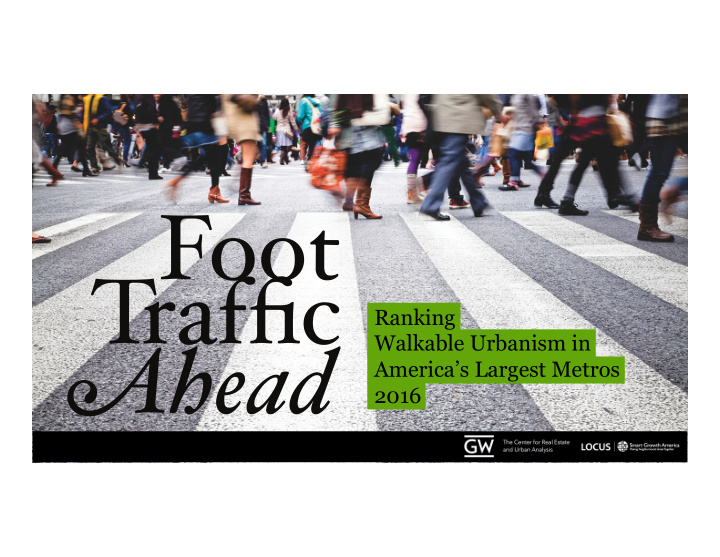



Ranking Walkable Urbanism in America’s Largest Metros 2016
The Largest 30 Metros in the United States SHARE OF SHARE OF U.S. POPULATION U.S. GDP 46% 46% 54% 54% LARGEST 30 METROS REST OF U.S.
The Old Dichotomy URBAN SUBURBAN
Time for New Lenses WALKABLE DRIVABLE URBAN SUB-URBAN
Form & METROPOLITAN LAND USE OPTIONS: Function of REGIONALLY SIGNIFICANT LOCAL SERVING Metropolitan America WALKABLE WALKUP: NEIGHBORHOOD Metro Area Acreage: 1% Metro Area Acreage: 2-6% URBAN BEDROOM COMMUNITY EDGE CITY DRIVABLE Metro Area Acreage:90-94 % Metro Area Acreage: 3-4% SUB-URBAN
WalkUPs Defined WALK SCORE: Walk Score ≥ 70 OFFICE & RETAIL SPACE: Office ≥ 1.4 million sq. ft. and/or Retail ≥ 340,000 sq. ft.
Key Findings Key Findings • There are 619 WalkUPs , or regionally significant walkable urban places, in the 30 largest metropolitan areas in the United States. • Six Highest-Ranked Metros: • New York City • Washington, DC • Boston • Chicago • San Francisco Bay • Seattle
Key Findings Key Findings • Walkable urban real estate product in the 30 largest metros commands a 72% rent-per-square-foot premium over rents in drivable sub-urban areas. • Office Space: 90% • Retail Space: 71% • Multi-Family Rental: 66% • All 30 metros have a walkable urban rent premium , ranking from 4-191% (most 20-97%) • And, these premiums have grown between 2010-2015 • All 30 metros for walkable urbanism gaining market share: 28 metros growing 77% to 4X faster over 6 yrs. • Walkable urban absorption in metro Boston over 6 years absorbing 93% of new space in 1.2% of land
Key Findings Key Findings • Walkable urban development is not limited to the revitalization of center cities; it is also the urbanization of select suburbs. • For example, nearly half (47%) of Washington, DC’s WalkUPs are located in its suburbs.
WalkUPs in Metro Frederick County Montgomery Washington, DC County • 44 WalkUPs • 408 acres on average • 17,500 acres or 1% of land mass Key: WalkUP Types DOWNTOWN Fairfax District of County Columbia DOWNTOWN ADJACENT Prince George’s URBAN COMMERCIAL County SUBURBAN TOWN CENTER Arlington URBAN UNIVERSITY County REDEVELOPMENT of DRIVABLE SUB-URBAN GREENFIELD / BROWNFIELD Alexandria
Key Findings Key Findings • The most walkable urban metro areas have substantially higher percentage of highly educated workers (college graduates over 25 years of age) and GDP per capita • These relationships are correlations. Determining the causal relationships will require further research.
Correlation: WALKUPS & EDUCATION • Significant correlation, but no causal link • % of workforce with college degrees: • Top 6 high-ranked metros: 40% • Low-ranked 7 metros: 30% • 33% higher Do not know if: • Highly educated people build walkable urban places or • Existing walkable urban places attract highly educated people
Correlation: WALKUPS & GDP per Capita • Significant correlation between walkable urbanisms & GDP per capita • C ausal link between Education of workforce & GDP per capita • $56,598 average GDP per capita for largest 30 metros • The top 6 high-ranked walkable urban metros have GDP per capita of $72,110 vs. 7 low ranked metros of $48,314 —or 49% higher • Comparable to difference between Germany VS Russia, Latvia or Croatia
Development Momentum Rankings 1. New York City 2. Boston 3. Detroit 4. Seattle 5. Phoenix 6. Washington, DC 7. Los Angeles
Key Findings Key Development Momentum Findings • Development momentum metrics show that some metropolitan areas, such as Detroit , Phoenix , and Los Angeles , are making some surprising and unexpected shifts toward walkable urban development . • Detroit: Nationally significant downtown turn around and strength in suburban downtowns, like Ann Arbor, Royal Oak and Birmingham • Phoenix: ASU causing Tempe and downtown Phx to explode, using light rail as ‘horizontal elevator’ • Los Angeles: Building on old rail-based walkable urban backbone, largest new rail system revives old downtowns
Counter-Intuitive Social Equity Outcomes PLATINUM • Shown above, substantial walkable urban rent premiums • Planning attainable housing to GOLD combat the natural effects of WalkUP development S-T • 70% of premium is land costs SILVER • BUT, highly walkable urban metros have 14 lower percentage point for moderate HH COPPER TRANSPORTATION costs RENT PREMIUMS SOCIAL EQUITY • Increased access to jobs: 2-3 X RATING more jobs accessible by moderate income HHs
Key Findings Key Social Equity Findings: Moderate Income HHs (80% AMI) • The most walkable urban metros have the highest social equity: • New York City • Washington, DC • Boston • San Francisco • Minneapolis-St. Paul Higher housing costs for moderate income HHs but substantial lower transportation costs, plus 2-3X more accessibility to employment NEED AGGRESSIVE ATTAINABLE HOUSING PROGRAM AT WalkUP LEVEL
Executive Summary Executive Summary • All 30 of the largest U.S. metros have rent per square foot premiums for walkable urban office, retail and rental multi-family housing • Walkable urban development is expanding market share in all 30 metros, drivable sub- urban losing market share; 1st time 60 years • Walkable urbanism correlates with a highly educated workforce and higher GDP per capita • High walkable urbanism metros have the highest social equity, in spite of rent premiums • These trends suggest FUTURE DEMAND for tens of millions square feet of WALKABLE URBAN DEVELOPMENT … Likely the end of sprawl .
Recommend
More recommend